Circular economy
Children help create circular futures
When the children’s creativity meets scientific expertise, new ideas are born – for example, about what the sustainable world of tomorrow might look like. Together with school children and the St. Gallen University of Teacher Education, Empa researchers are developing a children’s book about circular economy that is meant to inspire both young and old.
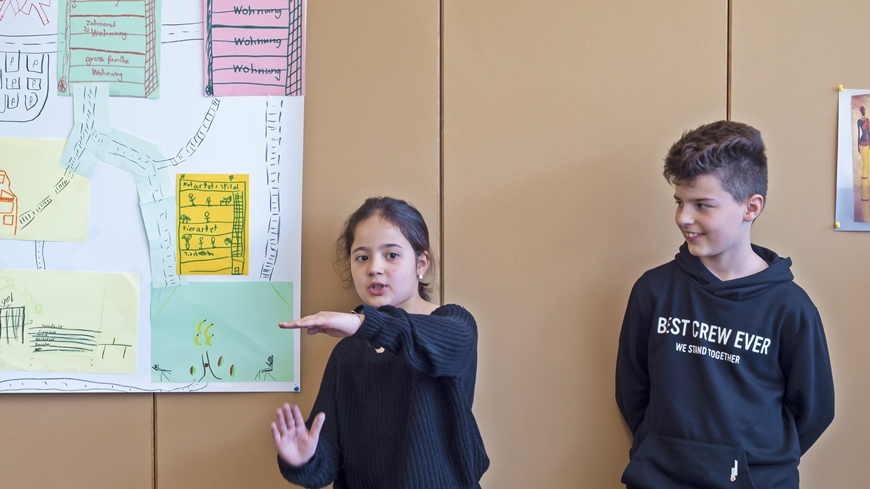
How will we travel in the future? According to Samuel, 10, we will use solar-powered airships instead of airplanes. Lara, 10, envisions traffic moving on three underground levels – one each for cars, the subway and trains. Other children imagine cars powered by compost or wind power. And maybe, adds nine-year-old Lars, we’ll take a vacation in the simulator or the cozy warm greenhouse next door and not have to travel so often in the first place.
The 13 third- to sixth-grade children gathered in a classroom at the St. Gallen University of Teacher Education (PHSG) on a Wednesday morning are bubbling over with ideas. Throughout the semester, they have been learning about topics related to the environment, energy and sustainable materials cycles in class and working in small groups to brainstorm how people might eat, live, travel and learn more sustainably in the future.
Today, the conversations in the groups are particularly lively because the children have visitors: Each table also has one or two researchers from Empa’s Technology and Society laboratory. The scientists ask questions, explain contexts and provide the scientific basis for the kid’s creative ideas. This is about more than just swapping ideas: Together, the children and the researchers are working on a children’s book about circular economy.
Visions of the future instead of just numbers
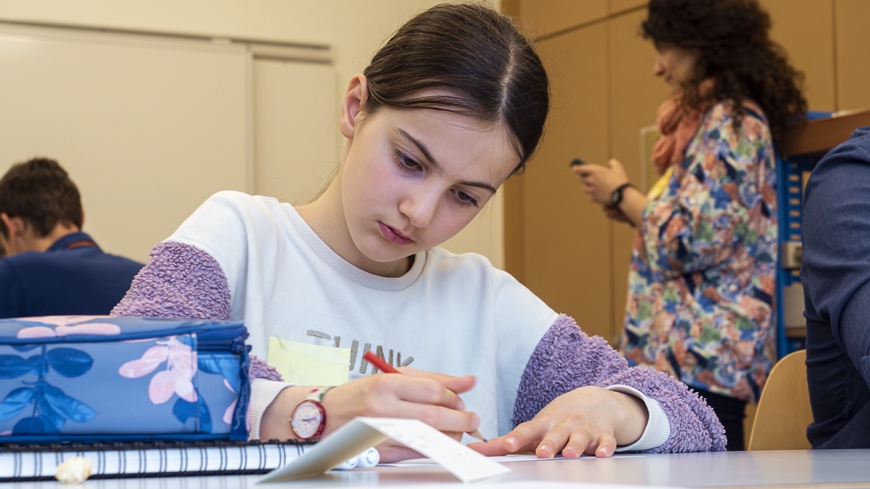
The project, officially called “Co-creating Circular Futures”, is supported by the Swiss National Science Foundation (SNSF) as part of the Agora program, together with the household appliance manufacturer V-Zug and the trade association SWICO. Project initiator Harald Desing came up with the idea during the Covid lockdown. “I realized that my two sons’ books almost exclusively depicted the world of yesterday,” the Empa researcher recounts.
In his own work, Desing deals with forward-looking topics such as the circular economy. “When we as scientists talk about a circular and sustainable future, it’s very abstract,” he says. “We show numbers, formulas and diagrams that are dry and often difficult to grasp.” Getting society to act, the researcher is convinced, will take more than facts: It will take a vision.
This is exactly what Empa researchers are now working on together with the school children and PHSG lecturers and students. The children are contributing their creativity and open-mindedness, while the scientists are providing a grounding in reality. “Adults have fixed ideas about how our system works,” Desing says. “If you ask them for solutions to our future, you will get a thousand reasons why this or that won’t work. But if you ask kids, you will get a thousand ideas.”
For the project, Desing is teaming up with the gifted education program at the PHSG. “You can study these topics with all children, not just the gifted ones,” emphasizes Marion Rogalla, head of the gifted education program in Rorschach and Rorschacherberg and an educational scientist at the PHSG. The gifted classes are best suited for such a project primarily for organizational reasons. “The children come to us for one morning a week throughout the semester, and we have the time to explore topics in depth, for example with games, experiments, technical input, theater scenes and sketched diaries.”
Of meat trees and solar trains
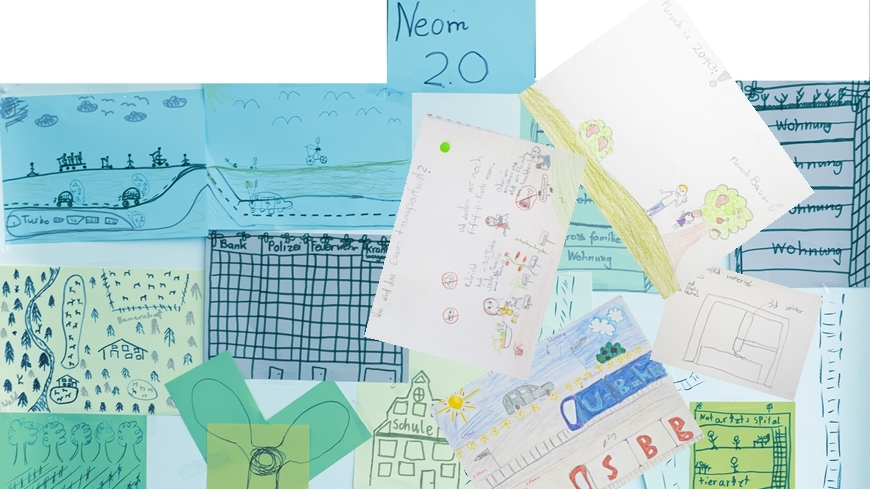
Although many adults approach sustainability issues with less than positive feelings, children have a different mindset, Harald Desing knows. “Children are open-minded. They like to be convinced by new ideas and take great pleasure in learning,” he says. The kids themselves confirm this. “It’s fun to use your imagination to think up things for the future,” says nine-year-old Lars. “I really like our idea for a train that produces its own electricity with solar panels and also supplies the station with electricity via the overhead line.”
The older children are also full of enthusiasm. “I learned a lot about the environment and sustainability. It was very interesting,” says Loreleyn, aged 13. Arjan, 12, adds, “I didn’t know that it takes several million years for a discarded glass bottle to decompose!” While Arjan talks pragmatically about electric cars and efficient appliances, Loreleyn is excited about the children’s idea for a “meat tree”. “There are many people who like to eat meat. If we could grow meat like a plant, it would be much more sustainable,” she says. “Of course, the meat tree is just an idea – but there are already laboratories today where people can produce meat without killing animals,” the girl knows.
And the researchers also enjoy working with the children. “The kids have brought a lot of ideas to the table and also asked us many questions,” says Desing. In a first joint workshop, the children and the researchers developed visions for sustainable cities of the future. A second workshop will focus on telling a story with characters set in that future world. Based on these two workshops, designer and artist Maya Ivanova will create the illustrated children’s book, which is expected to be published in early 2024. With accompanying material being developed by the PHSG, the book can then also be used in the classroom.
The children’s book project is not about predicting the future and showing the only right path to a sustainable world. “We want it to provide food for thought,” says Desing. And who knows – maybe one or two of the children’s ideas will also provide an impetus for research.
Inspiring the next generation
Scientific and technical professions in particular have difficulties attracting young people currently. In order to get school children interested in science and technology, various initiatives are underway at Empa. Every year, Empa welcomes around 100 children in grades 5 to 7 to the National Future Day and regularly offers guided tours for school classes. At the Smartfeld educational lab in St. Gallen, in which Empa is involved, children and young people combine technology with creativity in courses and experiment spaces. A summer camp is held every year in Dübendorf, where children gain insights into the world of research. In addition, many Empa researchers are active ambassadors, for example at the International Science Olympiads and at SATW's TecDays / TecNights.
Dr. Harald Desing
Empa - Technology and Society
Phone +41 58 765 7513
Prof. Dr. Marion Rogalla
St. Gallen University of Teacher Education (PHSG)
Phone +41 71 858 71 20
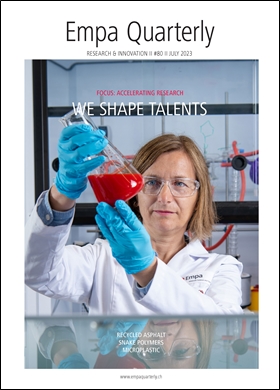
Empa Quarterly#80 Accelerating research
The young people of today are the decision-makers of tomorrow. In this issue, the focus is therefore not (only) on materials and technologies, but also on the people who make them possible: Researchers, founders, apprentices and students. Through support at all professional and academic levels, these talents can reach new heights in science or enter the Swiss economy as urgently needed skilled workers.
Read the latest EmpaQuarterly online or download the pdf-version.
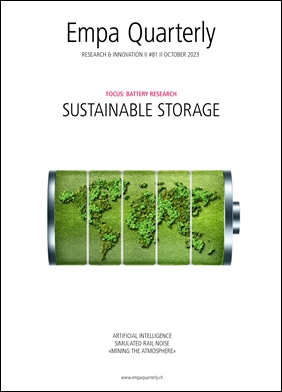
Empa Quarterly#81 Battery research
Being able to store energy is a central pillar of a sustainable energy system, since solar and wind energy are not always available in sufficient quantities when they are needed. Good batteries are indispensable for the energy transition, and thus for a more sustainable world. Empa researchers are developing batteries for different applications, from stationary energy storage to electromobility. They are also working on analyzing and recycling end-of-life batteries.
Read the latest EmpaQuarterly online or download the pdf-version.
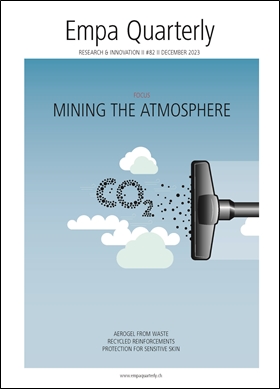
Empa Quarterly#82 Mining the Atmosphere
To limit climate change, we need to compensate not only for future emissions, but also for historical ones. One solution would be the "atmospheric vacuum cleaner": we remove the excess CO2 from the atmosphere. But what do we do with it? Instead of extracting the carbon for polymers, medicines, fibers, fuels and the like from crude oil, we use atmospheric CO2. This is the simple – yet extremely challenging in technical terms – idea behind Empa's new research initiative, Mining the Atmosphere.
Read the EmpaQuarterly online or download the pdf-version.
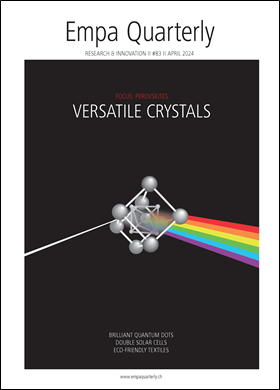
Empa Quarterly#83 Perovskites: Versatile cristals
Over 180 years ago, a curious crystal was discovered in the Ural Mountains. Today, it has given rise to an entire class of materials that is of great interest to researchers: perovskites. What all perovskites have in common is their crystal structure, which gives them unusual properties. By changing the exact composition of the perovskite, scientists can control these properties. Empa researchers are using this promising material to develop solar cells, detectors and quantum dots.
Read the EmpaQuarterly online or download the pdf-version.
-
Share






